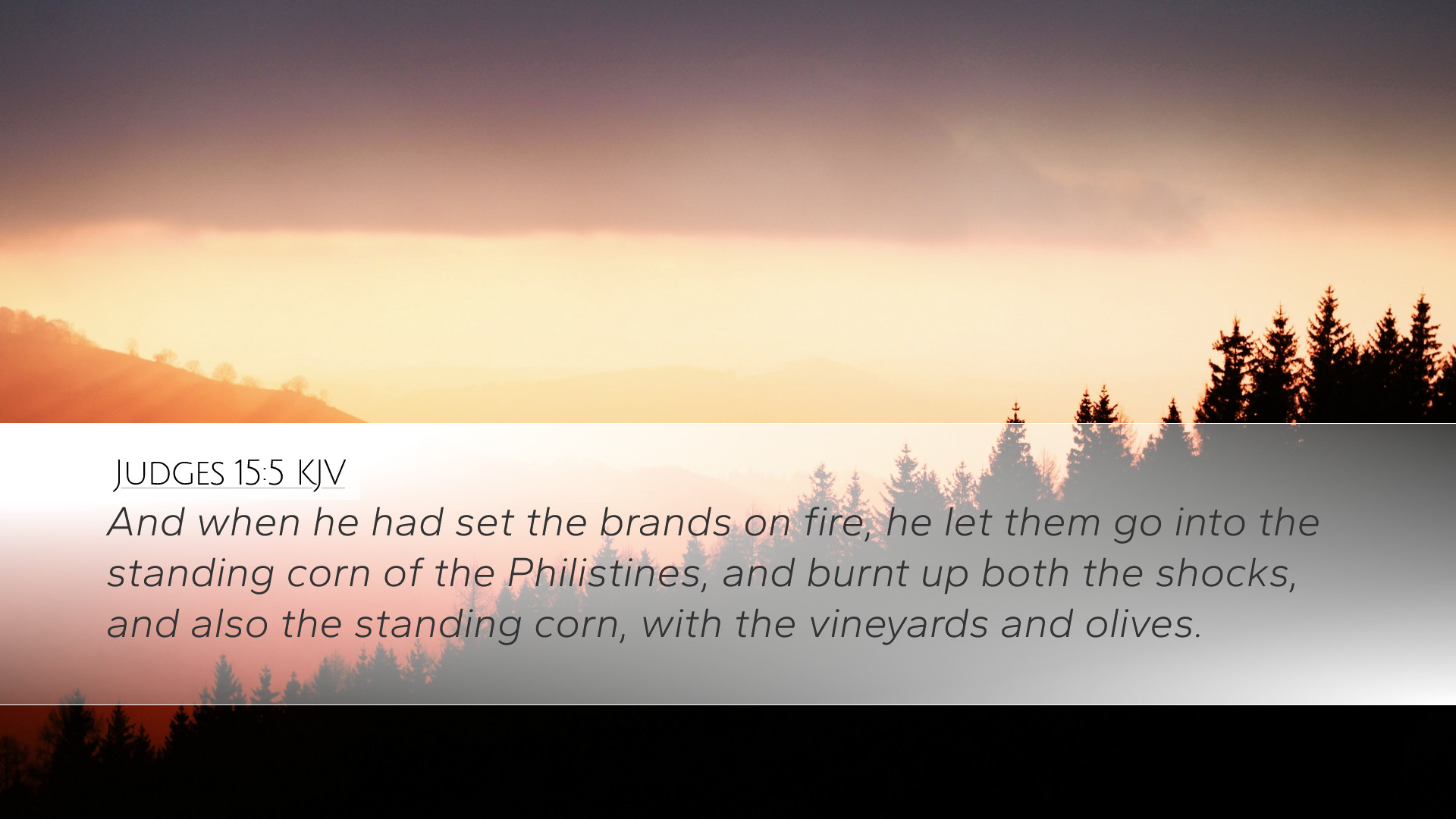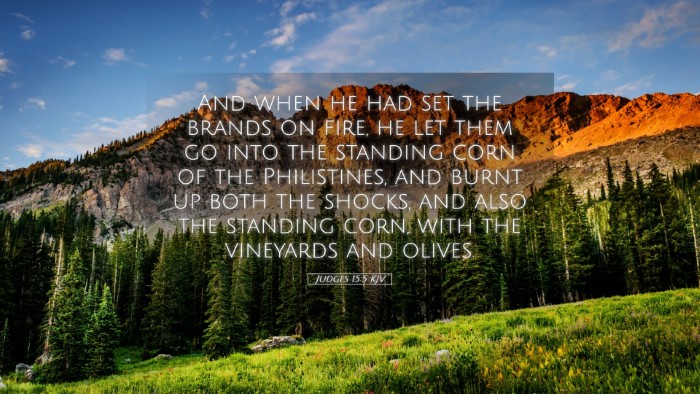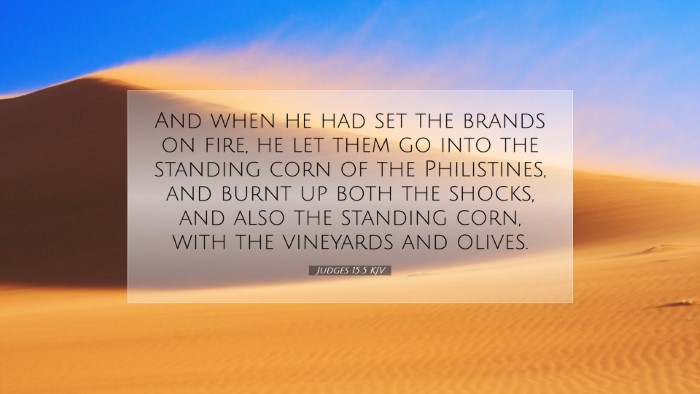Old Testament
Genesis Exodus Leviticus Numbers Deuteronomy Joshua Judges Ruth 1 Samuel 2 Samuel 1 Kings 2 Kings 1 Chronicles 2 Chronicles Ezra Nehemiah Esther Job Psalms Proverbs Ecclesiastes Song of Solomon Isaiah Jeremiah Lamentations Ezekiel Daniel Hosea Joel Amos Obadiah Jonah Micah Nahum Habakkuk Zephaniah Haggai Zechariah MalachiJudges 15:5
Judges 15:5 KJV
And when he had set the brands on fire, he let them go into the standing corn of the Philistines, and burnt up both the shocks, and also the standing corn, with the vineyards and olives.
Judges 15:5 Bible Commentary
Commentary on Judges 15:5
Judges 15:5 reads: “And when he had set the brands on the foxes, he let them go into the standing corn of the Philistines, and burnt up both the shocks and also the standing corn, with the vineyards and olives.” This verse describes a significant event in the life of Samson, demonstrating both his ingenuity and the dire conflicts between Israel and the Philistines.
Contextual Overview
The Book of Judges is characterized by a cyclical pattern of Israel's disobedience, oppression, repentance, and deliverance. The Israelites, having fallen into idol worship, face oppression from surrounding nations, particularly the Philistines. Samson, an Israelite judge, is raised by God to deliver His people, but his life is marked by personal failures and conflicts. This specific episode highlights his tactics against the Philistines, showcasing his physical strength yet complicated moral fabric.
Analysis of the Verse
Here we break down the verse to explore its implications and lessons:
-
Setting of the Action:
The act of using foxes—a clever and resourceful choice—reflects Samson's strategic thinking. He targets the agriculture of the Philistines, understanding their economic reliance on their crops.
-
The Symbolism of Fire:
Fire serves as a potent symbol throughout Scripture. In this context, it represents destruction and judgment. By burning the crops, Samson not only inflicts economic damage but also expresses God's judgment against the Philistines for their oppression of Israel.
-
The Consequences of His Actions:
Samson's actions lead to further escalation between him and the Philistines, setting the stage for continued conflict. This demonstrates a recurring theme in the Book of Judges: that human actions, even those intended for justice, can lead to unintended consequences.
Insights from Public Domain Commentaries
Matthew Henry's Commentary
Henry suggests that Samson’s burning of the corn crops symbolizes the judgment of God upon the Philistines for their oppression of His people. He highlights that Samson's actions were not merely driven by personal vendetta but were, in essence, an execution of divine justice. Henry emphasizes the cleverness of Samson in using the foxes, noting that it shows both humanity's ability to strategize and the depth of human sinfulness that engenders conflict.
Albert Barnes' Notes
Barnes provides insight into the practical aspects of Samson’s actions. He notes that setting fire to the standing corn and vineyards struck at the very heart of the Philistine's economy. Barnes reflects on the imagery of destruction, which serves as a declaration of war against the Philistines. Moreover, he points out that despite Samson’s method, which may appear brutal, it was a necessary response to the greater evil of oppression that the Philistines enacted upon Israel.
Adam Clarke's Commentary
Clarke delves into the significance of the fox as an animal used in this operation, suggesting that its fleetness and elusive nature symbolize the speed and cunning with which God's plans can be executed. He also observes that the action of burning not only represented retaliation but also provided a signal of divine involvement on behalf of the suffering Israelites. Furthermore, Clarke discusses how Samson's actions lead to further conflict, aligning with God’s larger plan for Israel’s deliverance.
Theological Reflections
This verse invites several theological reflections pertinent to the modern-day Christian understanding of God’s justice and the nature of conflict:
-
Divine Justice:
God’s judgment is present, even in the seemingly chaotic actions of humanity. Samson, in executing his vengeance, acts under divine purpose, which reminds believers that God actively works in human affairs, especially in the context of injustice and oppression.
-
The Complexity of God’s Instruments:
Samson serves as a complex figure: a deliverer who struggles with personal flaws. This speaks to the nature of God's chosen vessels, highlighting that He can employ those who may not be perfect in character but are essential in His plans. This offers hope and encouragement to those serving God, reminding them that effectiveness in ministry is not rooted in perfection but in divine calling.
-
Conflict and Resolution:
Samson's conflict with the Philistines shows that believers today may also find themselves in spiritual battles. The necessity of confronting injustice, even at a personal cost, is a poignant lesson for contemporary Christians. Believers are called to engage in spiritual warfare, utilizing the weapons of prayer, the Word of God, and righteous actions, to combat the forces of evil.
Conclusion
Judges 15:5 serves as a powerful reminder of God’s involvement in human history and His justice against oppression. Through Samson’s actions, we see the complexities of divine justice, human agency, and the near-constant presence of conflict in the life of faith. The insights gained from the public domain commentaries not only enhance our understanding of this particular verse but also challenge contemporary believers to reflect on their role in addressing injustice and fulfilling God’s purposes in a broken world.


